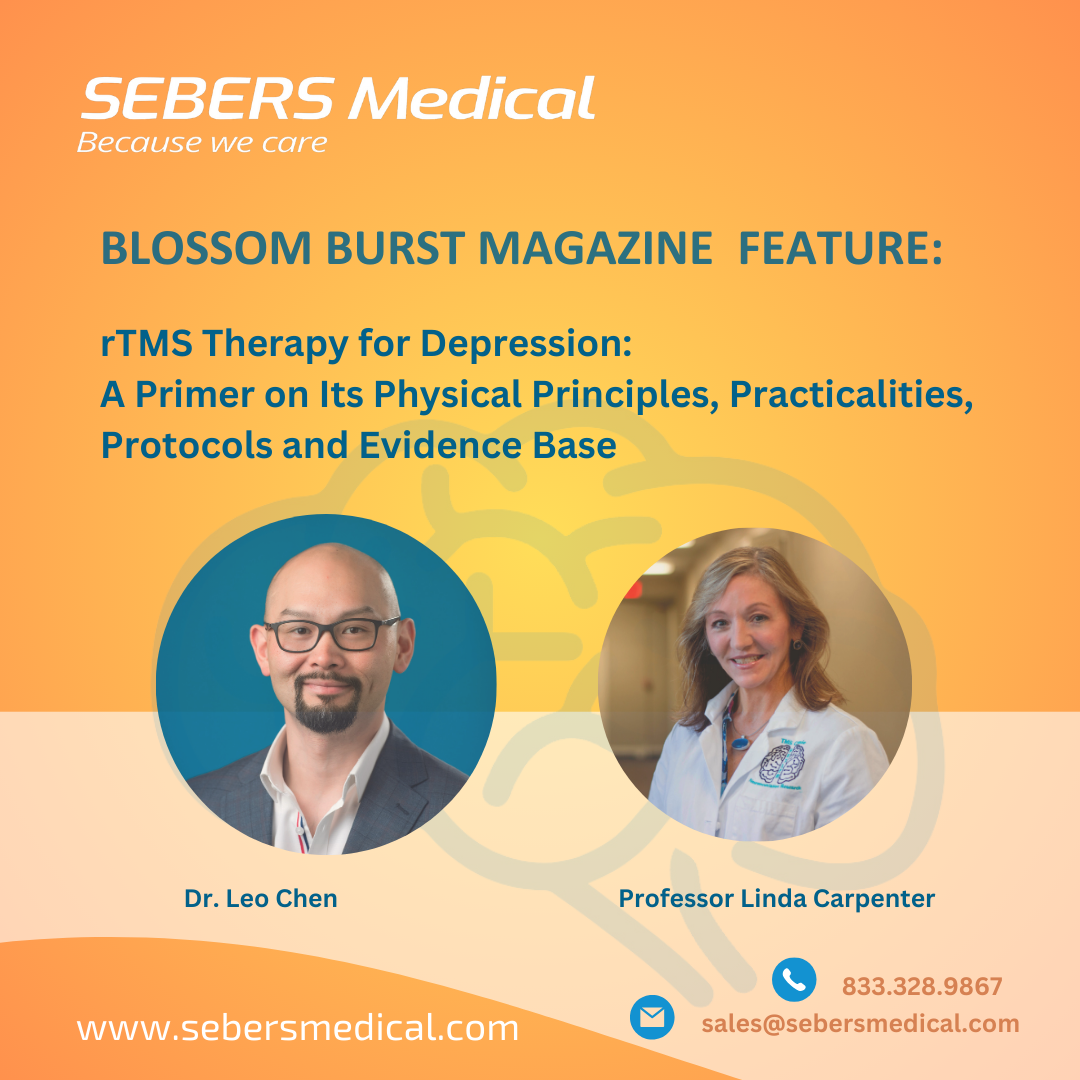rTMS Therapy for Depression:
A Primer on Its Physical Principles, Practicalities, Protocols and Evidence Base
Authors: Leo Chen and Linda L. Carpenter
Excerpt from our magazine: This blog post is an excerpt from our magazine. For a free digital or print version to read the full article and much more, visit us at https://sebersmedical.com/.
Introduction
Repetitive transcranial magnetic stimulation (rTMS) has gained global recognition as an effective and safe treatment for depression. Initial research trials conducted nearly 30 years ago demonstrated its potential, leading to extensive investigations into its physiological and therapeutic effects. Today, rTMS is a well-established treatment for major depressive disorder, particularly for patients who do not respond to antidepressant medications.
Fundamental Principles of rTMS
rTMS operates by applying electromagnetic pulses to stimulate nerve tissue beneath the stimulation coil and indirectly affecting remote brain areas through connections. The process involves discharging a pulsed electrical current from a stimulator to a TMS coil, producing a transient electromagnetic field. This field induces electrical fields in neurons located near the coil, resulting in increased or decreased neuronal excitability. Repeated rTMS sessions enhance neuroplastic effects, which are believed to contribute to its therapeutic efficacy.
Practical Application of rTMS
During rTMS therapy, patients remain awake, comfortably seated in a reclinable chair. Anesthesia or sedation is not required. The initial session involves locating the stimulation target, typically the left dorsolateral prefrontal cortex (DLPFC), and calibrating the stimulation intensity based on the patient’s motor threshold. Treatment sessions range from a few minutes to half an hour, usually conducted once daily for four to six weeks, followed by a tapering phase.
Evidence-Based Efficacy of rTMS
rTMS is endorsed by various clinical practice guidelines as an effective treatment for depression. Seminal trials have established the efficacy of 10 Hz rTMS delivered to the left DLPFC for treatment-resistant depression (TRD). Subsequent studies and meta-analyses have consolidated the evidence, confirming rTMS’s antidepressant efficacy, tolerability, and safety. Comparisons with other treatments, such as electroconvulsive therapy (ECT) and pharmacological augmentation strategies, have shown rTMS to be a highly effective intervention.
Alternative rTMS Protocols
Research has explored various rTMS protocols, including different stimulation frequencies and targets. Studies have shown that 1 Hz rTMS to the right DLPFC and sequential bilateral rTMS are also effective for treating depression. The H-coil, which stimulates broader cortical areas, has demonstrated superior efficacy in some trials. These findings highlight the versatility and adaptability of rTMS in clinical practice.
Future Directions
As rTMS continues to evolve, future research aims to address knowledge gaps, optimize treatment protocols, and personalize therapy through neuroimaging. The ongoing development of accelerated rTMS protocols and advancements in targeting specific brain regions hold promise for improving treatment outcomes and expanding the application of rTMS to other neuropsychiatric conditions.
About the Authors
Dr. Leo Chen is a Senior Research Fellow and Head of the Brain Stimulation Lab at Monash University, Melbourne, Australia. He is a Consultant Psychiatrist at Alfred Mental and Addiction Health and has contributed extensively to the field of therapeutic brain stimulation through clinical trials, peer review, and the development of clinical practice guidelines.
Professor Linda L. Carpenter is the Director of the TMS Clinic and Neuromodulation Research Facility at Butler Hospital and a Professor of Psychiatry at Brown University. Her research focuses on developing new treatments for depression, including device-based therapies, and she has served as Principal Investigator on numerous clinical trials.
For more detailed information and references, please refer to the original article published in our magazine. This blog post provides an overview of the key points and highlights the significant contributions of rTMS therapy in treating depression.
